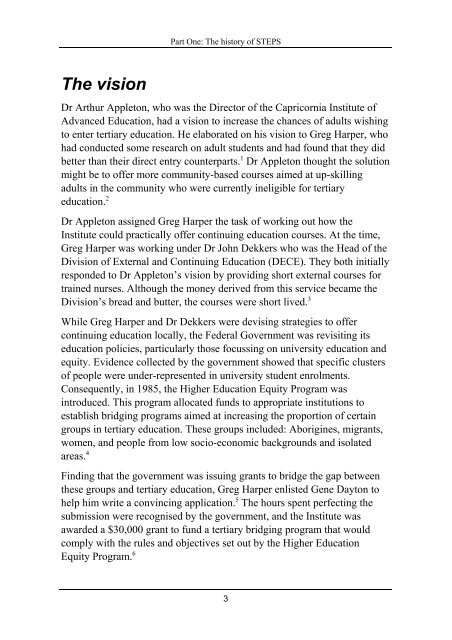STEPS - Library - Central Queensland University
STEPS - Library - Central Queensland University
STEPS - Library - Central Queensland University
You also want an ePaper? Increase the reach of your titles
YUMPU automatically turns print PDFs into web optimized ePapers that Google loves.
The vision<br />
Part One: The history of <strong>STEPS</strong><br />
Dr Arthur Appleton, who was the Director of the Capricornia Institute of<br />
Advanced Education, had a vision to increase the chances of adults wishing<br />
to enter tertiary education. He elaborated on his vision to Greg Harper, who<br />
had conducted some research on adult students and had found that they did<br />
better than their direct entry counterparts. 1 Dr Appleton thought the solution<br />
might be to offer more community-based courses aimed at up-skilling<br />
adults in the community who were currently ineligible for tertiary<br />
education. 2<br />
Dr Appleton assigned Greg Harper the task of working out how the<br />
Institute could practically offer continuing education courses. At the time,<br />
Greg Harper was working under Dr John Dekkers who was the Head of the<br />
Division of External and Continuing Education (DECE). They both initially<br />
responded to Dr Appleton’s vision by providing short external courses for<br />
trained nurses. Although the money derived from this service became the<br />
Division’s bread and butter, the courses were short lived. 3<br />
While Greg Harper and Dr Dekkers were devising strategies to offer<br />
continuing education locally, the Federal Government was revisiting its<br />
education policies, particularly those focussing on university education and<br />
equity. Evidence collected by the government showed that specific clusters<br />
of people were under-represented in university student enrolments.<br />
Consequently, in 1985, the Higher Education Equity Program was<br />
introduced. This program allocated funds to appropriate institutions to<br />
establish bridging programs aimed at increasing the proportion of certain<br />
groups in tertiary education. These groups included: Aborigines, migrants,<br />
women, and people from low socio-economic backgrounds and isolated<br />
areas. 4<br />
Finding that the government was issuing grants to bridge the gap between<br />
these groups and tertiary education, Greg Harper enlisted Gene Dayton to<br />
help him write a convincing application. 5 The hours spent perfecting the<br />
submission were recognised by the government, and the Institute was<br />
awarded a $30,000 grant to fund a tertiary bridging program that would<br />
comply with the rules and objectives set out by the Higher Education<br />
Equity Program. 6<br />
3
















